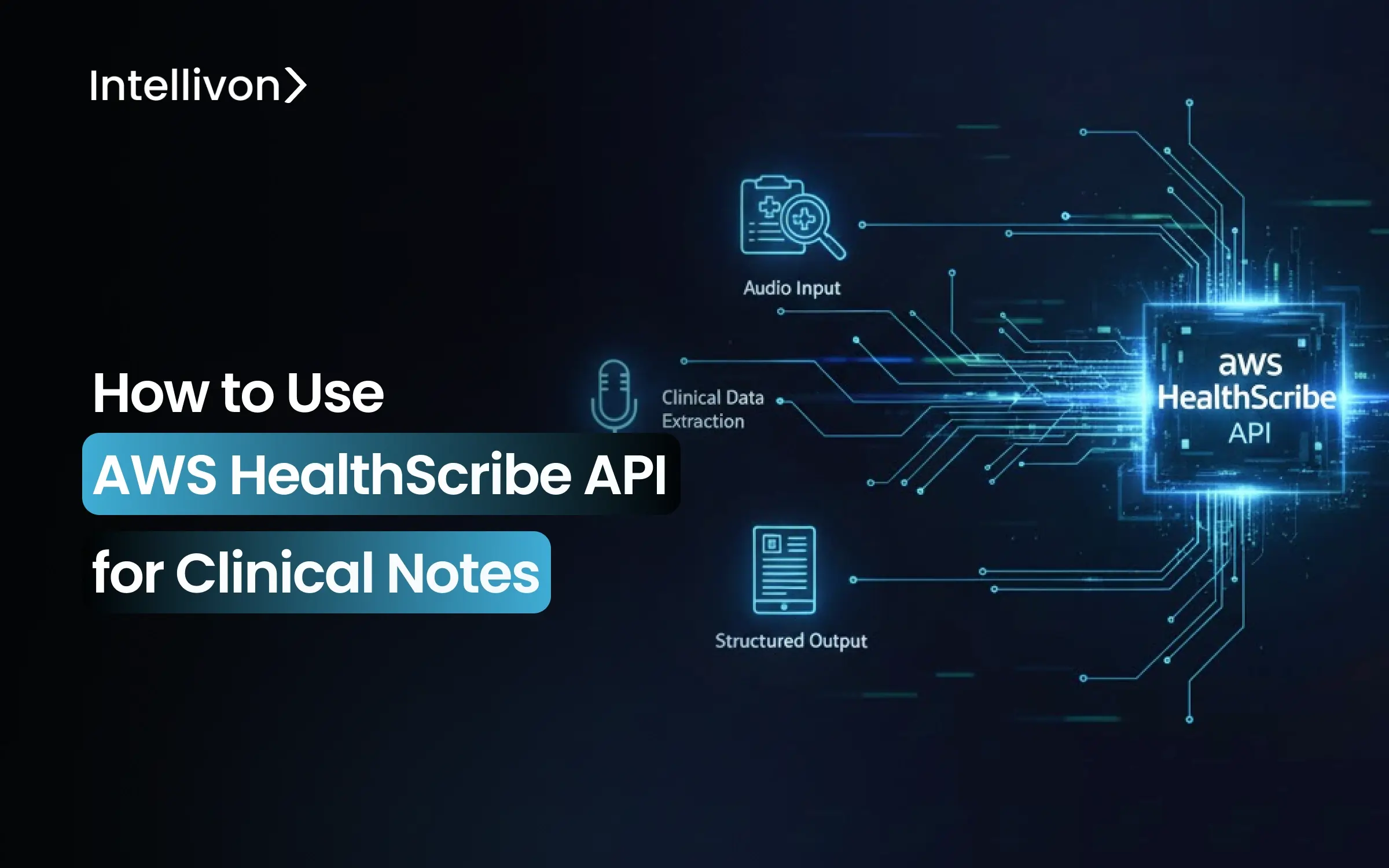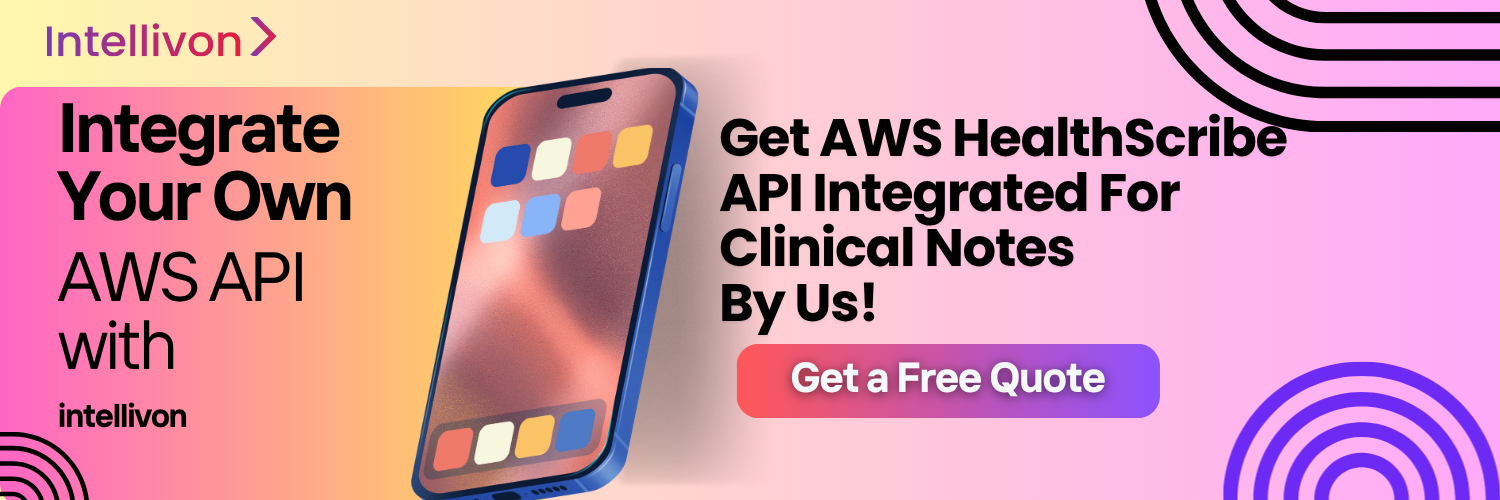Hospitals are struggling with clinical documentation. Every day, clinicians spend hours typing notes, correcting incomplete charts, and retracing steps through encounters they completed long ago. This ongoing administrative burden slows down care, creates billing gaps, and drains the energy of teams that are already stretched thin. AWS HealthScribe provides a better solution. It listens to natural conversations between clinicians and patients and turns them into organized notes inside the EHR. This reduces manual typing, cuts down on after-hours charting, and improves accuracy without changing how clinicians provide care.
At Intellivon, we assist organizations in implementing AWS HealthScribe in real clinical settings. This includes busy exam rooms, telehealth sessions, specialty consultations, and multi-hospital networks with strict governance needs. Our implementations understand clinical language, maintain accuracy at scale, and fit seamlessly into existing workflows. In this blog, we explain how AWS HealthScribe works, where it has the greatest impact, and how Intellivon prepares it for enterprise use to ensure long-term performance and measurable improvements in operations.
Why Clinical Note Automation Matters in 2025
AWS HealthScribe API is emerging as a strong contender in the clinical documentation automation market. It offers a HIPAA-eligible, generative AI service that creates structured clinical notes from patient-clinician conversations.
This comes at a time when the global medical transcription and documentation software market is projected to reach $8.41 billion by 2032, growing at 16.3% from 2025. The growth reflects a rising need for accurate, scalable tools that reduce documentation workload and improve clinical productivity.
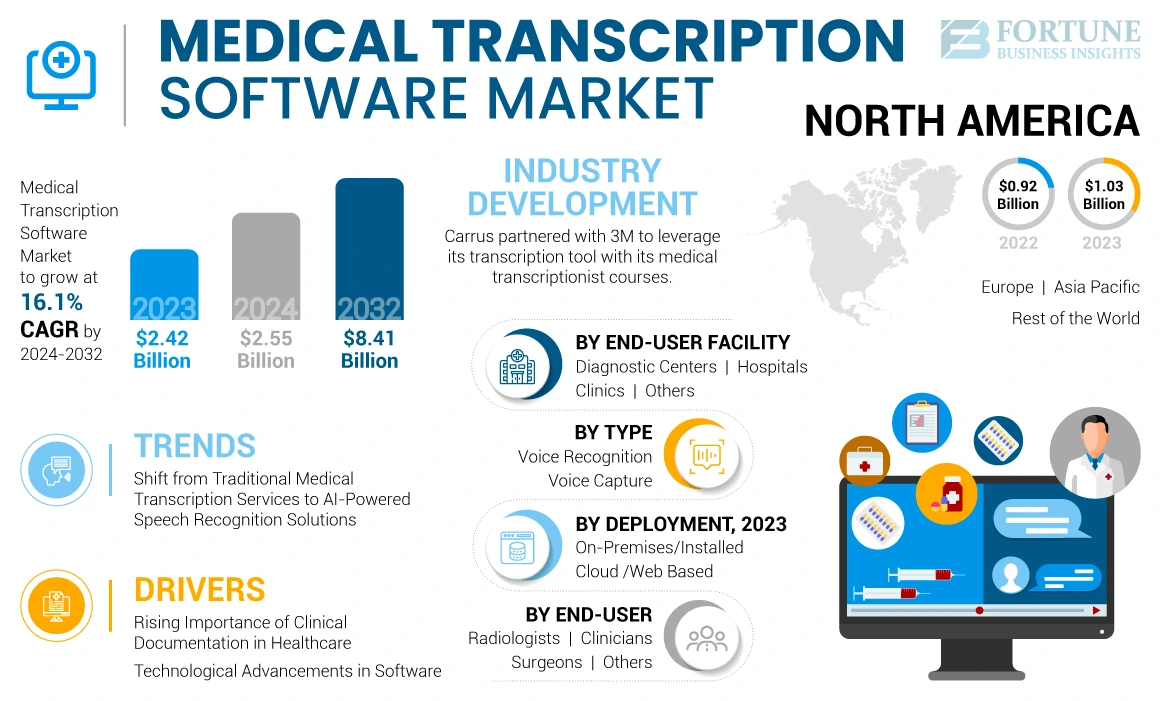
Key Market Metrics and Adoption
- AWS HealthScribe applies an API-first model that appeals to healthcare technology vendors and large enterprises seeking modular, integration-friendly tools.
- The service has demonstrated strong performance, with an F1 score of 87.4%, surpassing several peers in interpreting medical terminology and abbreviations.
- Adoption is closely tied to workforce pressure. Studies show 57% of physicians report burnout linked to documentation burden, and clinicians spend nearly twice as much time on administrative tasks as direct patient care.
- While the service currently supports general medicine and orthopedics, its cloud-native architecture and integration libraries make it attractive to organizations already operating within the AWS ecosystem.
- Transcript-linked references included in every AI-generated summary help administrators maintain auditability and clinical governance.
- By reducing manual note-taking, HealthScribe supports lower after-hours documentation and creates safer clinical environments through more consistent note quality.
- Usage-based pricing helps small practices with fluctuating encounter volumes pay only for what they use, while large systems benefit from elastic cloud scaling that aligns with high patient loads.
- As part of Amazon’s broader healthcare strategy, HealthScribe competes directly with specialized documentation vendors by offering deep EHR integration and streamlined data flows.
AWS HealthScribe positions itself as a scalable, cloud-ready documentation engine designed to reduce manual input, strengthen workflow efficiency, and deliver consistent clinical notes across departments. Its architecture fits well into health systems seeking automation that integrates easily, supports compliance, and aligns with broader digital transformation goals.
What is AWS Healthcribe API?
AWS HealthScribe API is a clinical note–generation service that turns patient-clinician conversations into structured draft notes. It uses medical speech recognition and generative AI to identify speakers, capture context, and summarize key details in standard clinical formats like HPI and Assessment and Plan.
Each generated sentence links back to the original transcript, giving clinicians a clear way to verify accuracy.
The API-first approach makes it easy for healthcare software vendors and enterprise teams to embed documentation automation into telehealth apps, mobile workflows, and EHR extensions. Its HIPAA-eligible design and data-non-retention policy support organizations that must protect patient information while improving documentation speed.
How AWS HealthScribe Differs From Other Ambient Documentation Tools
- It provides a traceable link between every summary sentence and the source transcript.
- It functions as an API rather than a standalone scribe app, giving teams full control over integration.
- It does not store or train on customer data, reducing privacy and compliance risk.
- It performs well with complex medical language, supported by strong clinical entity extraction benchmarks.
- It fits naturally into AWS-based infrastructures, reducing deployment friction for large systems.
AWS HealthScribe gives healthcare enterprises a scalable way to automate note creation while maintaining accuracy, transparency, and workflow flexibility.
How AWS HealthScribe API Generates Clinical Notes
Clinical documentation is only useful when it is accurate, consistent, and fast to produce. AWS HealthScribe improves this process by converting natural conversations into draft notes that clinicians can review and approve. The workflow is simple, predictable, and designed to fit into existing clinical systems without disrupting how teams work.
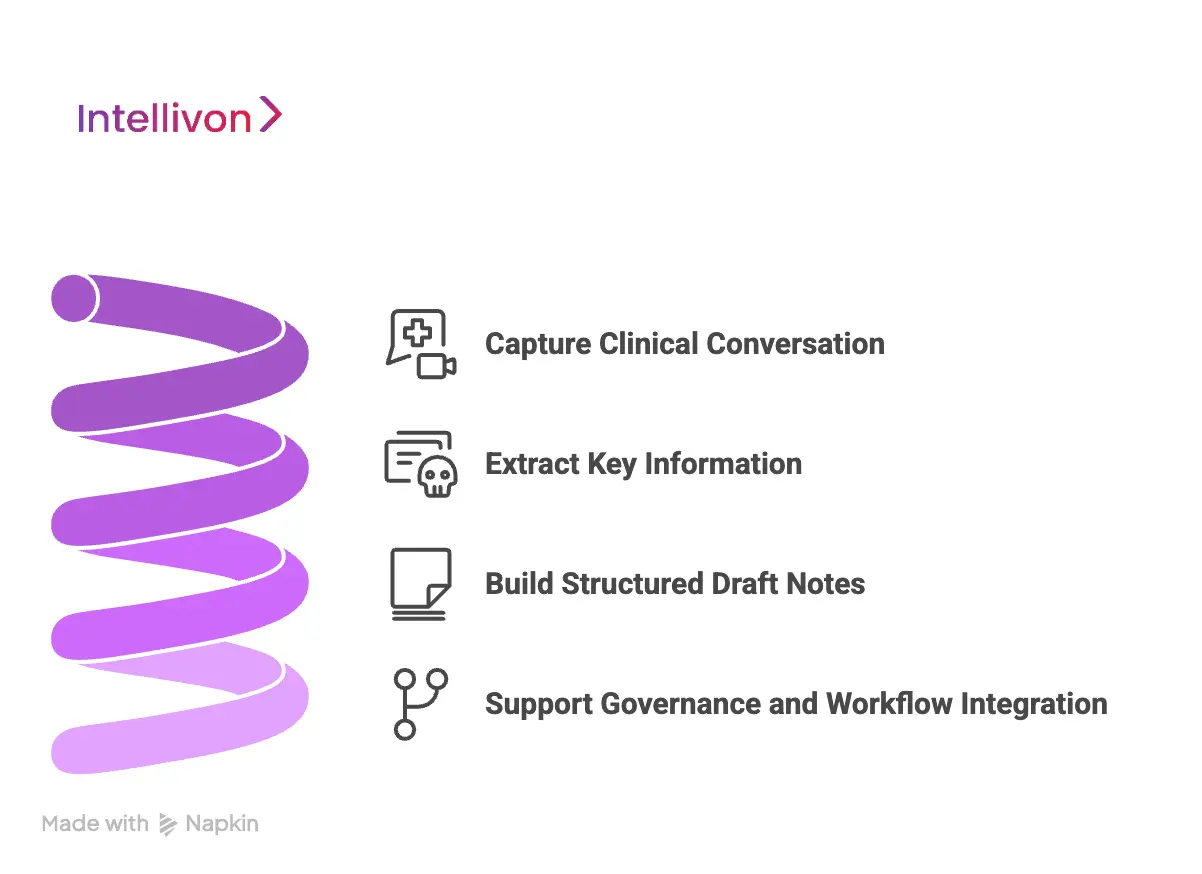
1. Capturing the Clinical Conversation
HealthScribe starts with audio recorded during a patient encounter. It identifies speakers, segments the dialogue, and generates a medical-grade transcript. This step uses speech recognition tuned for clinical terminology, acronyms, and conversational speech.
2. Extracting Key Information
Once the transcript is created, the API analyzes the language to understand clinical meaning. It extracts conditions, symptoms, medications, and relevant observations.
It also classifies segments based on their role in the encounter, helping the system understand what information contributes to the note.
3. Building Structured Draft Notes
After extracting context, HealthScribe generates structured draft notes following familiar clinical formats. Sections such as HPI, Assessment, and Plan are automatically produced.
Each sentence links back to the transcript, giving clinicians a simple way to verify accuracy and maintain trust in the record.
4. Supporting Governance and Workflow Integration
HealthScribe outputs structured data that can be integrated into EHR workflows or clinical documentation tools.
Because AWS does not store audio or text, healthcare organizations maintain full control over compliance, storage, and routing of clinical information.
By combining speech recognition, entity extraction, and structured summarization, AWS HealthScribe provides a streamlined approach to clinical note creation. It reduces the cognitive load on clinicians while supporting more consistent, review-ready documentation across encounters.
Key Benefits of Using AWS Healthscribe API for Healthcare Enterprises
Healthcare leaders need tools that reduce documentation load without adding operational complexity. AWS HealthScribe provides a focused set of benefits that support clinical accuracy, workflow flexibility, and long-term scalability. These advantages matter most when an enterprise is preparing for system-wide adoption.
1. Reduces Documentation Time at Scale
HealthScribe automates the early stages of note creation, helping clinicians move faster through their daily encounters.
By turning recorded conversations into draft notes, it removes repetitive typing and lowers the amount of time spent reviewing EHR fields. Over an entire year, this time savings becomes a measurable productivity gain for large health systems.
2. Strengthens Clinical Accuracy and Consistency
The API identifies medical terms, symptoms, medications, and other key entities with strong benchmark performance. This improves the quality of draft notes and reduces the variation that often occurs across departments.
The transcript-linked evidence included with each sentence also helps maintain a high standard of clinical governance.
3. Improves Clinician Experience
Documentation pressure is a known contributor to burnout. By reducing manual note-taking, HealthScribe helps clinicians spend more time with patients and less time completing records after their shift.
This creates a stronger workplace environment and supports long-term staff retention.
4. Accelerates Workflow Integration
HealthScribe integrates into mobile apps, telehealth platforms, and custom EHR extensions through its API-first design. Enterprise teams gain control over how, where, and when the notes appear within the workflow.
This flexibility shortens implementation timelines and helps departments adopt the tool without major process changes.
5. Enhances Compliance and Data Governance
AWS HealthScribe does not store or train on customer data. This design supports privacy, reduces security risk, and helps organizations maintain control over PHI. For enterprise compliance teams, this simplifies oversight and reduces friction during approval processes.
AWS HealthScribe delivers benefits that matter across clinical, operational, and financial dimensions. It creates faster, more consistent documentation workflows while reducing burden on clinicians. For enterprises seeking a scalable and secure way to improve note generation, HealthScribe offers a practical foundation to build on.
How Automating Clinical Notes Can Free 560+ Minutes Per Clinician
Across health systems, clinical documentation has quietly become one of the largest sources of inefficiency. In a study covering more than 100 million outpatient encounters, physicians spent an average of 16 minutes and 14 seconds in the EHR for each visit, and almost a quarter of that time was pure documentation.
Another national assessment found primary care physicians spending a median of 36.2 minutes per visit inside the EHR, even though many appointments were scheduled for 30 minutes. About 6.2 minutes of that happened after hours.
These numbers may look small when examined per encounter. When multiplied by a full schedule, the picture changes. A clinician handling 20 patients a day can easily lose more than 9 hours every week to documentation alone.
Why This Problem Affects Enterprise Performance
Documentation is not only a time issue. It influences throughput, financial performance, and clinician stability.
A UK analysis showed clinicians spend an average of 13.5 hours a week on documentation tasks, nearly a third of their working hours. Burnout follows closely behind. Research published by the AMA highlights that long documentation cycles are a top contributor to clinician fatigue and after-hours “pajama time.”
Operational ripple effects come next. Slow chart closure interrupts coding. Delayed coding postpones billing. Revenue capture slows down. And across clinics, documentation time varies sharply. In one system, the median time per visit ranged from 23.5 minutes to 47.9 minutes, depending on the site.
Such variability makes standardisation difficult and inflates labor costs, especially in large health systems where alignment across departments is essential.
Why 2025 is the turning point
The landscape in 2025 is different because ambient AI has matured. Speech-to-note technology now supports enterprise-grade accuracy, and health systems are now implementing tools that reduce clinician workload in measurable ways.
A year-long deployment of ambient AI scribes across a large US health system recorded 15,791 hours of documentation time saved across 2.5 million encounters. Another multi-site study of 1,430 clinicians reported that ambient documentation technology significantly reduced burnout prevalence, improving well-being scores across the board.
These results show that automation is no longer a niche tool. It is a proven strategy for improving operational efficiency and strengthening staff retention while supporting higher encounter volumes.
Clinical Note Automation As The Smartest Next Step
Automating clinical notes lifts pressure from clinicians while removing bottlenecks that quietly limit enterprise performance. Leaders who invest in this shift gain three advantages:
- More capacity without adding headcount: When note-taking time shrinks, clinicians can increase daily encounters without sacrificing quality.
- Stronger financial performance: Faster chart closure improves coding accuracy and reduces lag between care delivery and revenue capture.
- 3. Higher clinician satisfaction: Reducing after-hours documentation helps stabilise teams and strengthens long-term retention.
Documentation burden affects every dimension of a healthcare organisation. In a year where margins, staffing, and patient expectations continue to tighten, automating clinical note creation is one of the most direct ways to free time, reduce costs, and improve care delivery.
Enterprise Use Cases Where AWS HealthScribe API Excels
Different clinical settings carry different documentation pressures. AWS HealthScribe performs best in environments where encounters are conversation-heavy, documentation is repetitive, or chart closure directly affects operational flow. These use cases show where the API provides the strongest impact and how healthcare organizations apply it in real practice.
1. In-Clinic Consultations
Primary care and general medicine visits often involve detailed problem histories, follow-up questions, medication reviews, and shared decision-making. HealthScribe supports these interactions by converting natural conversations into structured draft notes.
3M Health Information Systems is using HealthScribe to power its ambient documentation tools, helping clinicians produce complete, review-ready notes without manually typing long histories.
2. Telehealth Encounters
Virtual visits require clinicians to manage video interaction, patient engagement, and documentation simultaneously. HealthScribe improves this workflow by generating transcripts and summaries directly from recorded telehealth conversations.
Netsmart integrates HealthScribe within its telehealth and virtual care platforms to automatically create progress notes and reduce documentation time during high-volume remote consultations.
3. High-Volume Ambulatory Clinics
Urgent care, walk-in centers, and outpatient clinics rely on rapid documentation to keep throughput steady and avoid after-hours charting. HealthScribe helps clinicians review and finalize notes faster by returning structured summaries immediately after each encounter.
ScribeEMR uses HealthScribe to optimize EMR workflows, speed up note creation, and support coding accuracy across high-volume outpatient settings.
4. Specialty Clinics With Repetitive Documentation
Specialties such as orthopedics, pain management, and rehabilitation often document the same clinical elements across visits, including pain scores, mobility changes, medication responses, and functional assessments. HealthScribe performs well here because it identifies and organizes recurring medical information consistently, reducing editing time and variation between clinicians.
This makes it suitable for specialty groups aiming to standardize note quality across large teams.
5. Team-Based Care Settings
In multi-disciplinary teams, multiple clinicians contribute to patient documentation. HealthScribe streamlines this by generating a single, structured draft note that nurses, assistants, coordinators, and physicians can refine together.
This reduces duplicated work and helps create consistent documentation across complex care pathways, especially in chronic care and transitional care models.
HealthScribe excels in settings where documentation is dense, repetitive, or directly tied to operational outcomes. Its ability to extract medically relevant information, structure notes consistently, and integrate into existing workflows makes it a strong fit for organizations seeking better chart accuracy, faster chart closure, and improved clinician effectiveness across departments.
How We Implement AWS HealthScribe API at Enterprise Scale
Successful implementation of AWS HealthScribe depends on more than connecting an API. It requires a careful transformation that protects clinical workflows, supports compliance, and improves chart-closure speed across the organization. Intellivon follows an eight-step model built for large health systems that need predictable outcomes and scalable performance.
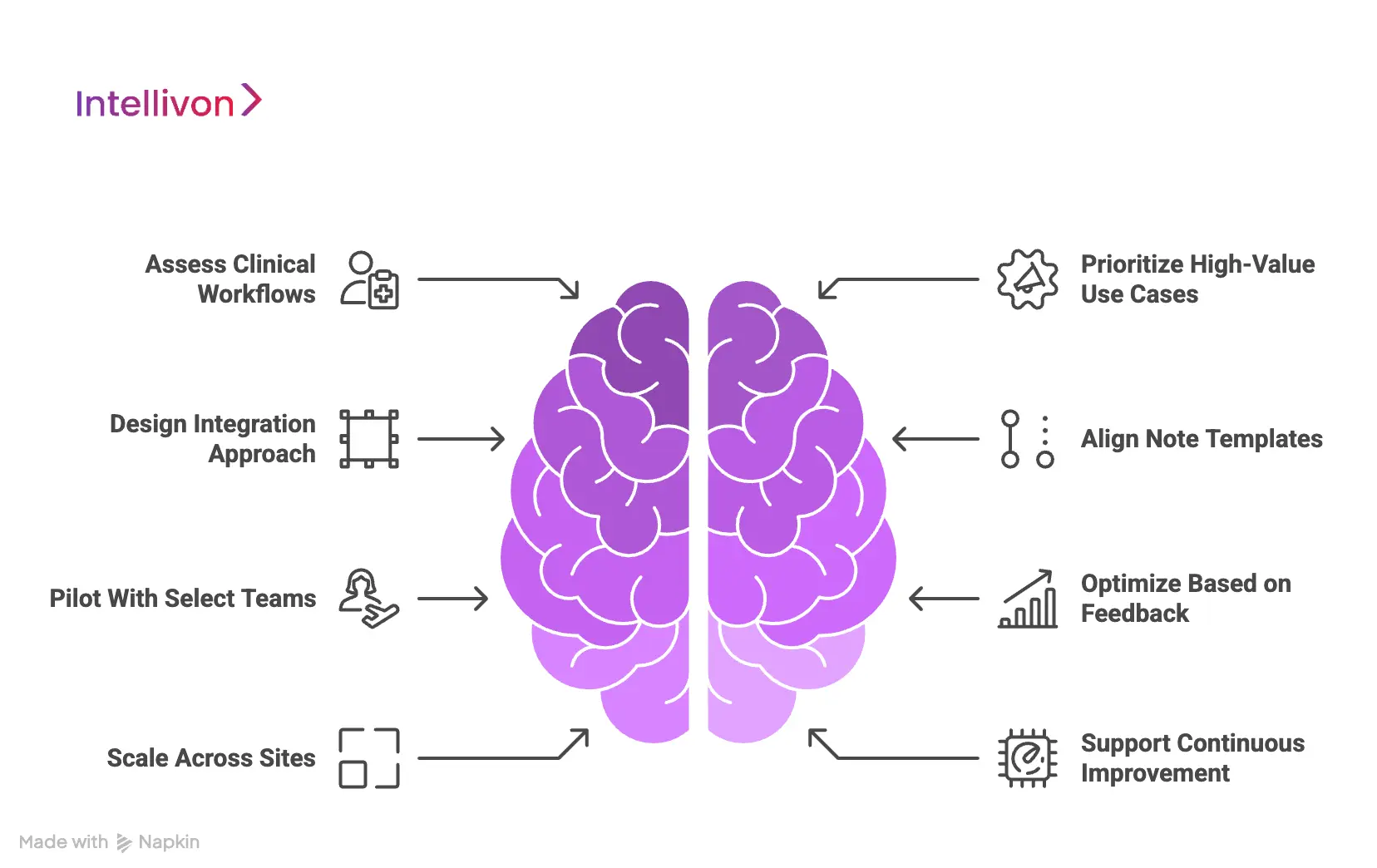
1. Assess Clinical Workflows
We begin by looking closely at how your clinicians capture information across departments. This includes understanding encounter flow, documentation style, chart-closure habits, and specialty-specific note patterns.
These insights help us identify where documentation slows teams down and where HealthScribe can create immediate operational relief.
2. Prioritize High-Value Use Cases
Not every workflow benefits equally from automation. Intellivon highlights areas such as primary care, orthopedics, urgent care, and telehealth, where narrative-heavy encounters and high daily volumes place extra pressure on clinicians.
Prioritizing these groups ensures early wins and smoother organization-wide confidence in the system.
3. Design Integration Approach
We design an integration plan that fits naturally into your existing clinical environment. This may include connecting HealthScribe to EHR extensions, telehealth platforms, mobile apps, or care-team tools. The goal is to keep workflows intact so clinicians do not need to change how they work to benefit from automation.
4. Align Note Templates
Draft notes must reflect your documentation standards. Intellivon configures HealthScribe output to match specialty templates, organizational terminology, and governance requirements. This alignment ensures clinicians spend less time editing summaries and more time focusing on patient care.
5. Pilot With Select Teams
We launch focused pilots in controlled clinical settings to validate accuracy, usability, and workflow fit. These pilots offer leadership insight into adoption barriers, documentation improvements, and real-world performance before scaling across the enterprise.
6. Optimize Based on Feedback
Pilot feedback helps refine the system. Intellivon adjusts prompting, extraction behavior, and summary structure to strengthen accuracy and consistency. We track chart-closure time, clinician workload, and coding patterns to measure operational impact and guide continuous improvement.
7. Scale Across Sites
With proven results, we expand the rollout in phases across clinics, hospitals, and specialty groups. This structured approach ensures each site has the support and onboarding it needs, minimizing disruption and ensuring consistent documentation quality across the organization.
8. Support Continuous Improvement
Documentation workflows evolve, and automation must evolve with them. Intellivon provides ongoing optimization, governance alignment, and performance monitoring to ensure HealthScribe remains accurate, reliable, and aligned with your operational goals over time.
This eight-step model ensures HealthScribe strengthens documentation workflows while supporting organizational efficiency. Intellivon manages every step so your teams gain measurable value without compromising clinical operations.
Cost Breakdown for Adopting AWS HealthScribe API
At Intellivon, our priority is to help healthcare enterprises implement AWS HealthScribe in a way that is compliant, resilient, and ready for real clinical scale. Pricing aligns with business goals, regulatory scope, and operational complexity. Every dollar is directed toward improving patient safety, workflow efficiency, and trusted documentation processes.
When budgets are tight, we adjust scope with stakeholders while preserving the essentials. We never compromise HIPAA or GDPR requirements. We prepare systems for the FDA and EU AI Act expectations. Each implementation balances cost control with sustainable compliance and clear ROI visibility.
Estimated Phase-Wise Cost Breakdown
| Phase | Description | Estimated Cost Range (USD) |
| Discovery & Compliance Alignment | Requirements gathering, risk mapping, HIPAA and GDPR scoping, metric definition | $6,000 – $12,000 |
| Architecture & Secure Design | PHI-safe design, encryption planning, resilience modeling, IAM structure | $8,000 – $15,000 |
| Audio Capture & Input Setup | Telehealth hooks, in-clinic audio, consent flows, signal improvements | $6,000 – $12,000 |
| HealthScribe Configuration & Note Generation | Transcript handling, entity extraction, structured notes, and accuracy scoring | $12,000 – $25,000 |
| EHR Integration & Interoperability | FHIR, HL7, SMART on FHIR, routing for Epic/Cerner/Meditech | $10,000 – $20,000 |
| Security & Privacy Engineering | RBAC, MFA, tokenization, redaction, monitoring workflows | $8,000 – $15,000 |
| Platform UX & Interfaces | Reviewer UI, coder view, dashboards, admin tools | $10,000 – $20,000 |
| Testing & Validation | HIPAA checks, functional QA, safety evaluation, performance tests | $6,000 – $10,000 |
| Pilot & Training | Limited rollout, refinements, team training, operational handoff | $6,000 – $10,000 |
| Deployment & Scaling | Cloud rollout, availability setup, cost controls, and elasticity | $6,000 – $12,000 |
Total Initial Investment Range: $50,000 – $150,000
Ongoing Maintenance & Optimization (Annual): 15–20% of initial build
Hidden Costs Enterprises Should Plan For
- Integration complexity: Legacy EHR variations may require additional mapping and workflow reconciliation.
- Compliance overhead: Audits, access reviews, and regulatory documentation demand recurring resources.
- Data governance: Normalizing structured and unstructured data across departments requires constant upkeep.
- Cloud spend: Real-time audio and note-generation pipelines need careful cost controls to maintain ROI.
- Change management: Training clinicians, coders, and care teams carries tangible transition costs.
- Model drift: Continuous tuning and validation ensure accuracy, fairness, and compliance stability.
Best Practices to Avoid Budget Overruns
- Start with a focused scope: Pilot one high-volume department before scaling system-wide.
- Bake in compliance early: Avoid costly redesigns triggered by missed regulatory requirements.
- Adopt modular components: Reuse templates and pipelines across service lines for faster expansion.
- Optimize cloud usage: Balance real-time and batch processing to manage compute costs.
- Ensure strong observability: Monitor uptime, latency, and integration health to prevent failures.
- Iterate for longevity: Update controls, refine templates, and recalibrate models as workflows evolve.
Request a tailored proposal from Intellivon’s healthcare AI team. We help enterprises align their HealthScribe roadmap with budget goals, compliance expectations, and long-term scalability needs.
How We Maximize HealthScribe API Performance Across Clinical Settings
HealthScribe delivers its strongest value when it is paired with the right workflows, data practices, and clinical review structures. Optimizing these elements ensures the system remains reliable, accurate, and clinically safe across departments. Intellivon works with enterprises to apply these improvements without disrupting care delivery.
1. Strengthen Audio Quality at the Source
Clear audio leads to stronger transcripts and higher-quality summaries. Clinical settings differ in noise levels, room acoustics, and microphone placement. Improving these basics has a direct impact on extraction accuracy. Simple changes such as consistent distance from microphones, reducing background noise, and using validated recording tools help HealthScribe capture the full clinical narrative.
2. Align Templates With Clinical Workflows
Different clinics require different documentation styles. Primary care needs context-rich HPI sections. Urgent care requires concise assessments. Orthopedics depends on structured details like mobility findings and pain scores.
Intellivon aligns templates with each specialty so HealthScribe outputs match what clinicians expect, reducing editing time and improving acceptance.
3. Use Specialty-Specific Prompts
HealthScribe performs at its best when prompts are tailored to the department’s needs. For example, orthopedics benefits from cues around range of motion and injury mechanism, while chronic care teams benefit from cues around symptoms over time. These subtle refinements help the system surface the right clinical details in summaries.
4. Build a Trustable Review Layer
Automation works only when clinicians feel confident reviewing it. Intellivon builds review flows where every sentence links to a transcript segment. This supports safe oversight and reduces time spent searching through long audio files. It also helps compliance teams maintain governance without adding new review burdens.
5. Monitor Performance Across Sites
Different locations often produce different results because workflows, visit types, and clinician habits vary. Tracking accuracy, completion time, and correction patterns helps identify where refinements are needed. Intellivon uses these insights to adjust prompts, templates, and audio setup so performance stays consistent across the enterprise.
Optimizing HealthScribe performance requires intentional refinement across audio quality, templates, review structures, and clinician workflows. When tuned correctly, the API becomes a reliable documentation partner that strengthens accuracy and reduces administrative time across care settings. Intellivon ensures each environment gets the configuration it needs to operate at its best.
Top Examples of Healthcare Enterprises Using HealthScribe
AWS HealthScribe is still early in its adoption curve, but several healthcare technology leaders have already integrated it into their platforms. These examples highlight how the API performs in real clinical environments and what types of outcomes organizations are beginning to see.
1. 3M Health Information Systems
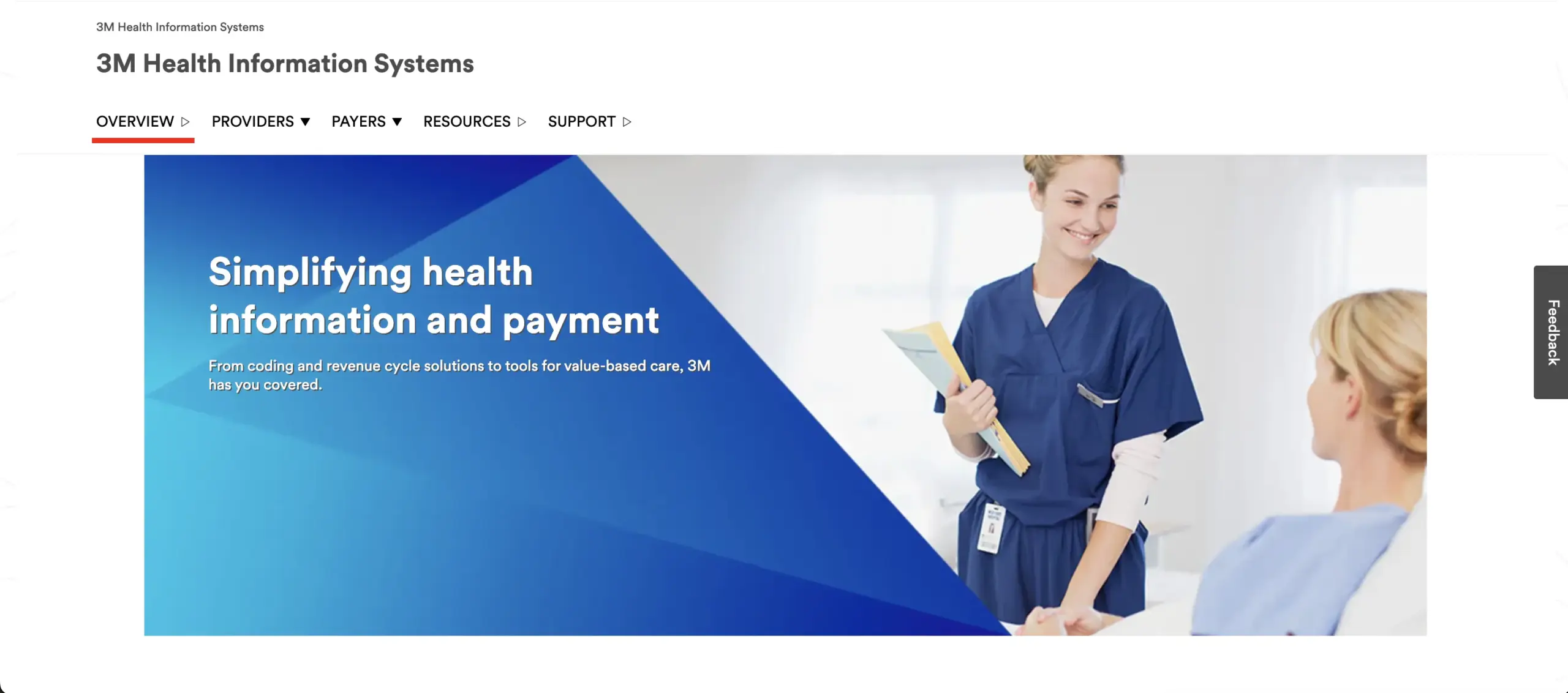
3M Health Information Systems is using AWS HealthScribe to enhance its ambient documentation and virtual assistant solutions. Their teams apply HealthScribe to convert clinician–patient conversations into structured draft notes that streamline downstream documentation and billing workflows.
This partnership signals enterprise confidence in HealthScribe’s accuracy, scalability, and compliance posture.
2. Netsmart

Netsmart integrates HealthScribe within its behavioral health, long-term care, and community care platforms. The service supports automated progress notes and discharge summaries, improving documentation speed across high-volume telehealth encounters.
Netsmart’s adoption demonstrates HealthScribe’s usefulness in care settings where fast, consistent documentation directly affects patient transitions and clinician workload.
3. ScribeEMR

ScribeEMR leverages HealthScribe to capture and interpret patient visits more efficiently, optimizing EMR workflows and coding processes.
Their teams report improved documentation quality and more predictable reimbursement cycles by reducing manual note preparation during outpatient and specialty visits.
Additional Early Adopters
Several healthcare technology vendors are also exploring HealthScribe within mobile charting tools, virtual care platforms, and physician productivity apps. These early adopters show a growing trend, where health systems want automation that fits their workflows without adding new administrative steps.
These examples illustrate how organizations are using AWS HealthScribe to reduce documentation time, improve note quality, and support clinicians across different care settings. As adoption grows, enterprises will continue to shape how ambient documentation tools strengthen operational performance and clinical efficiency.
Conclusion
Clinical documentation has always been a foundational part of healthcare, but the burden it places on clinicians and operations has grown beyond what manual workflows can sustain. AWS HealthScribe API offers a practical path forward by transforming natural clinical conversations into structured, review-ready notes. When implemented with intention, it not only reduces documentation time but also strengthens accuracy, consistency, and overall clinical throughput.
For healthcare enterprises navigating workforce pressure, rising administrative costs, and the need for more reliable documentation, solutions like HealthScribe are strategic tools that free clinicians to focus on care and help organizations operate with greater stability and speed. The systems that adopt this shift early will be the ones that gain long-term advantages in efficiency, patient experience, and enterprise resilience.
Integrate AWS HealthScribe API With Intellivon
At Intellivon, we implement AWS HealthScribe in a way that delivers medical-grade accuracy, regulatory alignment, and enterprise-wide performance. Our integrations reduce manual documentation time, improve chart-closure speed, and enhance coding quality while fitting seamlessly into existing EHR, telehealth, and mobile workflows. Each deployment is engineered for modern healthcare systems: secure, scalable, and built for measurable ROI from day one.
Why Partner With Intellivon?
- Compliance-First Architecture: Every HealthScribe deployment aligns with HIPAA, GDPR, FDA SaMD, and EU AI Act requirements.
- Healthcare-Tuned AI Alignment: We tune summarization patterns, specialty templates, and entity extraction strategies using real clinical workflows.
- Seamless EHR Interoperability: Intellivon integrates HealthScribe outputs into Epic, Cerner, Meditech, and custom EHR environments using FHIR, HL7, and SMART on FHIR.
- Scalable Cloud-Native Infrastructure: Our HealthScribe implementations support multi-site deployments, high-volume clinic loads, and low-latency performance.
- Continuous Optimization Through MLOps: We monitor accuracy, template alignment, workload patterns, and chart-closure times to refine outputs over time.
- Zero-Trust Security Framework: Every layer of the pipeline is secured with encryption, identity management, network segmentation, and continuous threat detection. PHI remains protected without adding friction to clinical workflows.
- Human-Centered Design: Clinician review screens, coder dashboards, and administrative controls make it easy to validate and finalize AI-generated notes.
- Proven Healthcare Expertise: Intellivon’s reference architectures, clinical workflow knowledge, and compliance maturity ensure implementations succeed at scale.
Book a strategy call with Intellivon to explore how AWS HealthScribe can reduce documentation load, improve note accuracy, and scale seamlessly across your hospital network.
FAQs
Q1. How does AWS HealthScribe improve clinical documentation accuracy?
A1. HealthScribe identifies medical terms, symptoms, medications, and clinical context with strong benchmark performance. Each generated sentence links back to the original transcript, allowing clinicians to verify accuracy quickly and maintain consistent documentation across encounters.
Q2. Is AWS HealthScribe compliant with healthcare privacy regulations?
A2. Yes. HealthScribe is a HIPAA-eligible service, and AWS does not store or retain audio or text processed through the API. Organizations maintain full control over PHI routing, storage, and governance, which simplifies compliance with HIPAA, GDPR, and internal security policies.
Q3. Can AWS HealthScribe integrate with our existing EHR system?
A3. HealthScribe integrates through an API, allowing teams to embed generated notes into EHR extensions, mobile apps, or telehealth platforms. Intellivon helps align these outputs with your templates and EHR workflows to ensure smooth charting and minimal disruption.
Q4. What types of clinical settings benefit most from HealthScribe?
HealthScribe performs well in primary care, telehealth, urgent care, orthopedic clinics, and other specialties with narrative-heavy visits. It also supports team-based care environments where multiple clinicians contribute to the same patient record.
Q5. What does it cost to implement AWS HealthScribe at enterprise scale?
Costs depend on workflow complexity, integration depth, and compliance scope. Most enterprise implementations fall between $50,000 and $150,000 for initial deployment, with annual optimization and maintenance typically ranging from 15–20% of the build.


